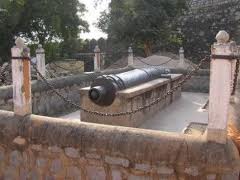Jhansi State facts for kids
Quick facts for kids
Jhansi State (1804–1858)
Jhansi (1728–1804)
|
|||||||||||
|---|---|---|---|---|---|---|---|---|---|---|---|
|
Flag
|
|||||||||||
| Capital | Jhansi | ||||||||||
| Government | Vassal state | ||||||||||
|
|||||||||||
Jhansi was once an important princely state in India. It was ruled by the Maratha Newalkar dynasty. From 1804 to 1853, it was under the protection of British India. However, the British took control of the state in 1853 using a rule called the Doctrine of Lapse. Before this, from 1728 to 1804, Jhansi was part of the Peshwas' lands. The capital city was Jhansi, a strong, fortified town.
Later, Rani Laxmi Bai, also known as Manikarnika, became a very important leader. She was a key figure in the Indian Rebellion of 1857. She ruled Jhansi from August 1857 to June 1858. The state's flag was a saffron banner, a color linked to Hinduism.
Contents
History of Jhansi State
Early Days: Bundela Rajputs
The area around Jhansi was first controlled by the Chandela rulers. It was once called Balwant Nagar. In the 11th century, Jhansi became less important. But in the 17th century, it grew strong again. This happened under Raja Bir Singh Deo I of Orchha. He ruled from 1605 to 1627. Raja Bir Singh Deo had good ties with the Mughal emperor Jahangir.
Between 1613 and 1618, Raja Bir Singh Deo built the famous Jhansi Fort. Around the fort, he created a town. This town was first called Balwant Nagar, but it later became known as Jhansi.
Maharaja Chhatrasal was a Bundela ruler from Panna. His lands were often attacked by Muslim governors of the Mughal Empire. In 1729, Mohammed Khan Bangash attacked Chhatrasal. So, in 1732, Chhatrasal asked the Marathas for help. The Peshwa, Baji Rao I, helped Maharaja Chhatrasal. Together, they defeated the army of Muhammad Bangash.
Under the Peshwas of Pune
After Maharaja Chhatrasal died two years later, Peshwa Baji Rao I received a reward. He was given one-third of the Maharaja's lands. Jhansi was part of this gift. This is how Jhansi became a Maratha territory.
A Maratha general helped develop the city of Jhansi. He brought people from Orchha state to live there. In 1742, Naro Shanker became the subedar (governor) of Jhansi. He governed for 15 years. During his time, he made the Jhansi Fort even bigger. The fort was very important for defense. He also built other structures. The part of the fort he added is called Shankergarh.
In 1757, Naroshanker was called back by the Peshwa. Other governors followed him. These included Madhav Govind Kakirde and Babulal Kanahai. Babulal Kanahai ruled from 1757 to 1766. Next came Vishwas Rao Laxman, from 1766 to 1769. Then, Raghunath Rao II Newalkar took over. He was a very good leader. He managed to increase the state's income. He also built the Maha Lakshmi Temple and the Raghunath Temple.
Jhansi Becomes a State
From 1804 to 1853
In 1804, the British promised to protect the Maratha governor, Rao Shiv Rao Hari Bhau. This made him almost independent from the Peshwas of Pune. He took the title of Rao of Jhansi in 1804. He became the first Rao of Jhansi. His state covered a large area of about 4,059 square kilometers.
Later, in 1818, a new agreement was made. This was between the Peshwa Baji Rao II and the British East India Company. This treaty meant that the Peshwa no longer had legal claims in Bundelkhand.
Shiv Rao died in 1814. His grandson, Ramchandra Rao, became the next ruler. He signed a second treaty with the British on November 18, 1817. This treaty confirmed that his family would rule the territory for generations. In 1832, the British gave him the title of Maharajadhiraj. Ramchandra Rao died in 1835.
After his death, Raghunath Rao III became the ruler. The British gave him a special title. But Raghunath Rao III was not a good ruler. He was so weak that the British took over the state's management. When he died in 1838, his brother, Gangadhar Rao, became the Raja of Jhansi in 1843.
Raja Gangadhar Rao was married to Rani Laxmi Bai. Before he died, he adopted a child named Anand Rao. This child was his cousin's son. Anand Rao was renamed Damodar Rao. The adoption happened with a British officer present. The Raja also gave a letter to the officer. In the letter, he asked that the child be treated kindly. He also asked that his widow, Rani Laxmi Bai, be allowed to govern Jhansi for her lifetime.
Raja Gangadhar Rao died in November 1853. Because Damodar Rao was adopted, the British East India Company used the Doctrine of Lapse. This rule meant that if a ruler died without a natural heir, their state would become part of British territory. So, the British rejected Damodar Rao's claim to the throne. They took over Jhansi state.
Jhansi state, along with the Jalaun and Chanderi districts, was then put under a British superintendent. In March 1854, Rani Lakshmibai was given a pension of 60,000 rupees. She was also told to leave the palace and the fort. Rani Lakshmibai asked the Governor-General and then the British government to recognize Damodar Rao's right to the throne. However, her request was denied.
Khaniadhana became a separate princely state after Jhansi was taken over.
The Rebellion of 1857

The Indian Rebellion of 1857 began, and Jhansi was ready for revolt. In June, some soldiers from the 12th Bengal Native Infantry took control of the fort. The fort held the state's money and weapons. On June 8, 1857, they killed the European officers, their wives, and children.
After this event, Rani Laxmi Bai felt she had to take charge of the city. She wrote to Major Erskine, a British official. She explained why she had taken control. The Rani's forces also stopped an attempt by other rebels. These rebels wanted to put a rival prince on the throne. The Rani's forces captured and imprisoned this prince.
Then, forces from Orchha and Datia invaded Jhansi. These states were allies of the British. But their real goal was to divide Jhansi between themselves. The Rani asked the British for help. However, the British now believed she was responsible for the killings. So, she received no reply. She gathered her own forces. These included soldiers from former Jhansi territories and some rebels. In August 1857, her forces defeated the invaders. At this time, she still wanted to hold Jhansi for the British.
From August 1857 to January 1858, Jhansi was peaceful under the Rani's rule. The British had said they would send troops to keep control. But no troops arrived. This made some of her advisors believe that Jhansi should be fully independent from British rule.
When British forces finally arrived in March 1858, they found Jhansi well-defended. The fort had powerful cannons that could fire over the town. Sir Hugh Rose, who led the British forces, demanded that the city surrender. He warned that if they refused, the city would be destroyed.
The Rani defended Jhansi against the British troops. Sir Hugh Rose began his attack on Jhansi on March 23, 1858. The bombing started on March 24. But Jhansi fired back strongly, and any damage to its defenses was quickly fixed. The defenders asked Tatya Tope for help. An army of over 20,000 soldiers, led by Tatya Tope, came to help Jhansi. But they failed to break the siege when they fought the British on March 31.
During the battle with Tatya Tope's forces, part of the British army continued to attack Jhansi. By April 2, the British decided to storm the city through a break in the walls. Four groups of soldiers attacked at different points. Those trying to climb the walls faced heavy fire. Two other groups had already entered the city. They were moving towards the palace. There was strong resistance in every street and every room of the palace. Fighting continued into the next day. Many people were killed during this time.
The Rani left the palace and went to the fort. After thinking, she decided that fighting in the city was useless. She had to leave and join either Tatya Tope or Rao Sahib. The Rani escaped during the night with her son and her guards. In April 1858, many people in Jhansi died after the city was stormed.
Rani Lakshmibai died from her wounds in a battle near Gwalior on June 17 or 18. It was not until November 1858 that the British fully controlled Jhansi.
Later Developments
In 1861, the city of Jhansi and its surrounding area were given to Gwalior State. The capital of the district was moved to a new town. This new town was called Jhansi Naoabad, which means "Jhansi Refounded." It was a village without a military camp.
Old Jhansi became the capital of a "subah" (province) within Gwalior state. But in 1886, it was returned to British rule. This happened in exchange for the Gwalior Fort and the nearby military camp of Morar. Because of this trade of land, the area came directly under British control again. It became part of the United Provinces.
Images for kids






